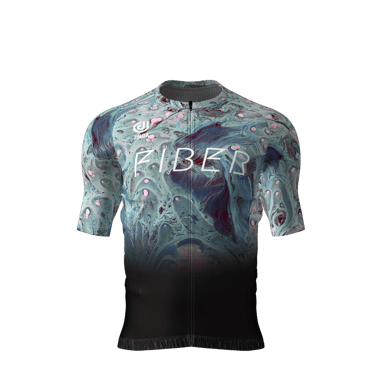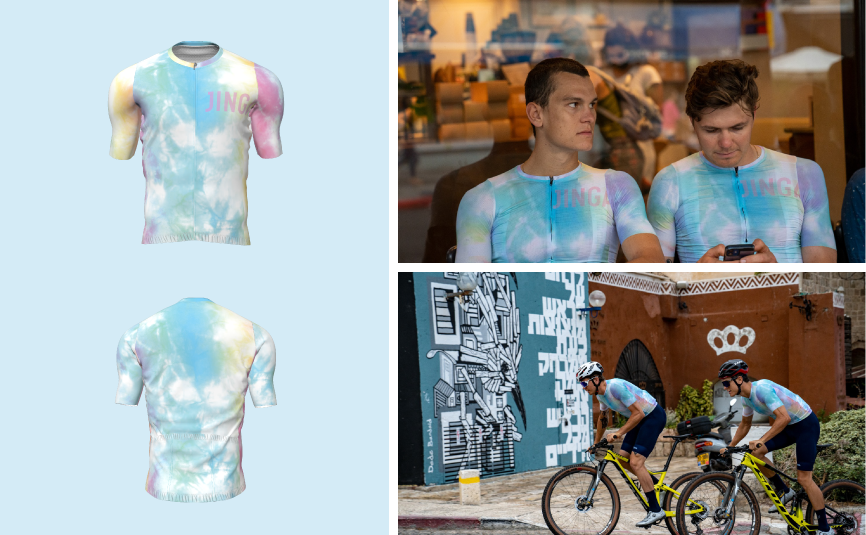Golden Island International X Browzwear
By utilizing Browzwear’s 3D fashion design software, VStitcher, they transformed their customers’ sketches into true-to-life digital samples.

 About the Company
About the CompanyEstablished in 2011 by Olympic MTB coach, Aviad Izrael, Jinga clothing specializes in designing and manufacturing custom, high-quality professional cycling wear for elite-level cyclists, runners, and swimmers of all ages. The company has developed cycling gear for dozens of global events and professional groups including UCI Pro Teams. Producing a wide range of products, Jinga is dedicated to continually broadening its customer community by catering to every need and pocket. In recent years, the company has experienced significant growth, embracing an innovative and forward-looking approach to its core design and production processes.
As a company dedicated to providing customized garments for professional sportspeople at speed, there is no doubt that quality and fit are critical to its success. Therefore the team at Jinga began to look for innovative ways to take their garment construction and sample presentations to the next level to provide customers with a seamless experience. When considering implementing digital tools, the brand searched for a solution that would enable them to better their products, speed time-to-market, reduce the number of physical samples needed throughout the process, and enhance communication with manufacturers overseas. With this set of goals, Jinga turned to Browzwear in 2018 to begin its digital transformation journey.
 Digital Adoption
Digital AdoptionWhen beginning the 3D adoption process, the product development and design teams were determined to build each garment from scratch with the goal to adopt an entirely digital design process without relying on physical resources. That way, they would also be able to leverage 3D garments for sales and marketing purposes, at a pre-production level. As much of Jinga’s product line is designed for specific events or teams, one of the most beneficial parts of creating garments in 3D was to ensure accurate team or sponsor logo placement and applying the graphics across different sizes. “In the early stage of our 3D adoption process, we’re able to leverage Browzwear’s 3D design software, VStitcher, to ensure that any graphics or logos were placed on the garment exactly where they should be and where they would be most visible,” says Aviad Izrael, Founder, Jinga Clothing. “ After getting the hang of the software, we could clearly visualize and easily manipulate the angles, sizing, location, and positioning of the 3D avatar, to make sure that each garment was just right before sending it to production,” he adds.
After making significant headway with incorporating 3D into the initial design process, the company was eager to progress and perfect the fit of their garments. “The way we see it is that the more familiar we become with the software, the more components we can eliminate from the physical design to production processes,” says Aviad. In fact, it was at this time that the world saw the onset of the pandemic with nationwide lockdowns commencing in early 2020, leaving Jinga little choice but to move full speed ahead on its digital journey as its customers geared up for upcoming cycling events. “Being able to work with a tool like VStitcher during such times of uncertainty enabled us to continue moving forward without needing to put upcoming projects on hold ,” says Aviad.

As the company began to prepare the professional team’s uniforms for the Israel Cycling Academy world tour, it was clear that travel bans would not stand in the way for Jinga. “We were given the task to produce cycling uniforms for 32 riders located all over the world without being able to carry out in-person fittings or travel to the production facilities. So we took this opportunity to create several avatars to represent some of the riders and built the garments entirely digitally,” he added. Prior to the onset of the pandemic, the team at Jinga would typically travel to China between three to four times a year, to create the physical samples and carry out the product approval process. However, since implementing 3D, even the most complex of products could be designed and finalized remotely, while still getting the desired results.
As part of the project, the company was also determined to improve the quality of the riders’ shorts, to ensure maximum riding efficiency and comfort by eliminating any inconveniences such as chafing while riding. In order to do so, the design team recreated a real-life photograph of a cyclist in action, into a true-to-life 3D render, discovering that the pattern pieces needed adjusting to enhance the overall fit . By working in 3D , the team was able to analyze each pattern piece, and restructure the design according to the stress and tension maps in VStitcher in order to accommodate the cyclists’ movement while riding, and ensure they had maximum flexibility. “After making the final adjustments to the 3D garment, we produced and sent several physical samples to the riders and the feedback was outstanding, enabling us to go straight to production,” says Aviad.

In addition, the company also saw this challenging period as an opportunity to bring virtual garments into the world of eCommerce. By doing so, new products could be launched, displayed as true-to-life 3D renders, and sold on their website without having to photograph the physical version. As Aviad notes , “Once the garment has been created in VStitcher and approved digitally, we can then share the DXF file and tech pack with the manufacturers without needing to see a physical sample first. It can then be sent straight to production.”
As Jinga continues to solidify its 3D implementation and embed it across the supply chain, the benefits brought about so far have been remarkable. To start, whereas overseas travel had been an essential part of the product development process for Jinga, having the ability to communicate quickly and efficiently over digital samples with customers, manufacturers, and production facilities enabled the company to significantly reduce travel and significantly cut back on its carbon footprint. When planning for the coming year, the company has calculated that in 2022, 3D will enable them to avoid 5 transatlantic flights, 50-60 express samples (and the associated production and shipping costs), enabling them to save 13.3 metric tons of CO2. “I am confident that with the capabilities of VStitcher, we will be able to continue to transform our sampling and product development culture at Jinga for the better and I look forward to taking our next steps with Browzwear’s 3D,” says Aviad.


By 2022 the team will be able to avoid 5 transatlantic flights

In addition, they will save 13.3 metric tons of CO2

Reduced production and shipping costs

The digital garment can be sent straight to production

3D garments used for eCommerce selling
“The way we see it at Jinga is that the more familiar we become with the software, the more components we can eliminate from the physical design to production processes. Being able to work with a tool like VStitcher during such times of uncertainty enabled us to continue moving forward without needing to put upcoming projects on hold.”

By utilizing Browzwear’s 3D fashion design software, VStitcher, they transformed their customers’ sketches into true-to-life digital samples.
To get underway with 3D adoption and embark on its digital journey, the company decided to adopt Browzwear’s fashion design solution VStitcher.
Paladin's adoption of Browzwear's 3D technology marked a transformative phase in its design and production processes.